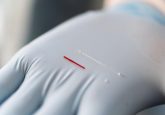Tiny ovarian tumors could be detected by new synthetic biomarkers

As it is often diagnosed at a late stage, patient survival rates for ovarian cancer are frequently poor. Five-year survival rates can however be increased to greater than 90% if the cancer is detected early. A new and far more sensitive method to identify ovarian tumors has now been developed by Massachusetts Institute of Technology scientists (MA, USA).
In mice, tumors smaller than 2 millimeters in diameter have been detected using the technique, which could translate into human ovarian cancers being identified up to 5 months earlier than is currently possible with blood tests.
In the new test, a nanoparticle that interacts with tumor proteins is utilized, releasing fragments that can be detected in urine. This method can produce a much clearer signal than the small quantities of natural biomarkers found in a patient’s bloodstream.
“What we did in this paper is engineer our sensor to be about 15 times better than a previous version, and then compared it against a blood biomarker in a mouse model of ovarian cancer to show that we could beat it,” commented senior author Sangeeta Bhatia (MIT’s Koch Institute for Integrative Cancer Research, MA, USA).
First reported in 2012, this method of using synthetic biomarkers to detect cancer measures the activity of endoproteases. In order to detect these endoproteases, the researchers designed nanoparticles coated with peptides that can be cleaved by matrix metalloproteinases. These particles collect at the tumor site and are then further cleaved into tiny reporter fragments that are then detected in the urine of the patient.
A mathematical analysis published in 2015 by the team demonstrated that detecting tumors 5 millimeters in diameter would require an improvement of the system’s sensitivity by at least one order of magnitude. In order to boost the sensitivity of technique the researchers used two strategies. They first optimized the length of the polymer used to tether the peptides to the nanoparticle with the second adding a tumor-penetrating peptide to the nanoparticles, which increased accumulation of the nanoparticles at the tumor site.
The combination of these two refinements in technique resulted in a 15-fold enhancement in sensitivity. This allowed detection of tumors 2 millimeters in diameter in mice. Current techniques that use blood-based biomarkers or ultrasound are only able to detect tumors of approximately 1 centimeter in diameter, which is roughly 8–10 years after they form. The ability to detect a tumor 5 months earlier could translate into real differences for patients.
Microarrays were also utilized by the researchers to detect proteases in tumor cells taken from patients with cancer. This could eventually allow targeting of the technique for different types of cancer, or even individual patients.
“Every patient’s tumor is different, and not every tumor will be amenable to targeting with the same molecule,” Bhatia concluded. “This is a tool that will help us to exploit the modularity of the technology and personalize formulations.”
Sources: Kwon E.J, Dudani J.S, Bhatia S.N. Ultrasensitive tumour-penetrating nanosensors of protease activity. Nat. Biomed. Eng. 1 (4) doi:10.1038/s41551-017-0054 (2017); www.sciencedaily.com/releases/2017/04/170410123940.htm






